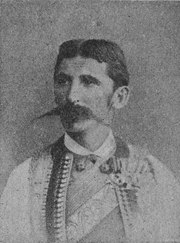| Vojvoda Božo Petrović-Njegoš | |
|---|---|

| |
| Božo Petrović-Njegoš in 1900 | |
| President of the Council of State of Montenegro | |
In office 20 March 1879 – 19 December 1905 | |
| Monarch | Nicholas I of Montenegro |
| Preceded by | Position established |
| Succeeded by | Lazar Mijušković (as President of the Ministerial Council of Montenegro) |
| Personal details | |
| Born | 1846 |
| Died | 1929 (aged 82–83) |
| Political party | Independent |
Božo Petrović-Njegoš (Cyrillic: Божо Петровић-Његош; 1846−1929) was a Montenegrin vojvoda and politician. After taking command of Southern Army in the Montenegrin–Ottoman War of 1876–1878, he represented the Principality of Montenegro at the Congress of Berlin.[1] He served as head of government of Montenegro from 1879 to 1905.[2]
Life[]
Božo studied in Paris. He returned to Montenegro following his studies. As cousin of Prince Nikola, Božo served as heir apparent from 1860 to 1871, when Nikola's first son Danilo was born.[1]
Božo was the commander of the Southern Army during the Montenegrin–Ottoman War of 1876–1878. He had great success in the Battles of Medun and Trijebač.[3] However, in his memoirs, vojvoda Ilija Plamenac claims he was the de facto leader of the Southern Army as Božo was too young and inexperienced.[4] After the war, Božo was the Montenegrin representative at the Congress of Berlin.[1] He was a candidate for Prince of Bulgaria in 1879.[5]
After the Congress, Božo served as head of government for more than 25 years. First as President of the Senate, and after that as President of the Council of State from 1879 to 1905. He retired from politics with the proclamation of the liberal 1905 Constitution of Montenegro. In 1915, he was made governor of Shkodër and Malësia following their occupation in World War I.[1]
Božo was jailed in December 1918 during the events that led to the creation of Yugoslavia. He was arrested near Nikšić with his two younger brothers, general Đuro Petrović and former district councilor Marko Petrović. All three were interned in Podgorica. Božo and Marko were released after almost one year, and were later interned in Sarajevo. General Đuro was kept in Podgorica where he suffered from cataract.[1][6]
He died in 1929 and is buried in the Church of St. Sava graveyard in Erakovići, near Cetinje.[7]
References[]
- ↑ 1.0 1.1 1.2 1.3 1.4 Jovović, Pantelija (1924) (in Serbian). Crnogorski političari. Belgrade: Štamparija "Vreme". pp. 7–8. http://montenegrina.net/wp-content/uploads/2014/12/CRNOGORSKI-POLITICARI.pdf. Retrieved 15 October 2019.
- ↑ http://rulers.org/rulm2.html#montenegro
- ↑ Miller, William (1907). The Balkans: Roumania, Bulgaria, Servia and Montenegro. New York: G. P. Putnum's Sons. p. 461. https://depts.washington.edu/cartah/text_archive/miller/m4_c7.html. Retrieved 15 October 2019.
- ↑ Plamenac, Ilija (2004). Andrijašević, Živko; Burzanović, Slavko. eds (in Montenegrin). Memoari. Podgorica: CID. p. 89. ISBN 86-495-0282-2.
- ↑ Цанев, Стефан (2008) (in Bulgarian). Български хроники: Том 3. Sofia: TRUD. p. 57. https://books.google.rs/books?id=JPEhC0oXsIAC. Retrieved 16 October 2019.
- ↑ (in Montenegrin) Nekoliko stranica iz krvavog albuma Karađorđevića. Rome: Odbor crnogorskih izbjeglica. 1921. pp. 20–21.
- ↑ "Najviše crkava i manastira posvećenih Svetom Savi imamo u Crnoj Gori" (in Serbian). IN4S. 28 July 2019. https://www.in4s.net/najvise-crkava-i-manastira-posvecenih-svetom-savi-imamo-u-crnoj-gori/?lang=lat. Retrieved 16 October 2019.
External links[]
| Wikimedia Commons has media related to Category:Božo Petrović-Njegoš. |
The original article can be found at Božo Petrović-Njegoš and the edit history here.